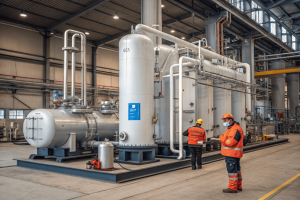What is the combustion catalytic oxidation method?
•
What is the combustion catalytic oxidation method?
Are you struggling with harmful VOC emissions from your industrial process? Traditional thermal incinerators require extremely high temperatures, leading to massive fuel costs and operational challenges.
The combustion catalytic oxidation method is a process that uses a catalyst to destroy harmful gases at a much lower temperature. It converts volatile organic compounds (VOCs) and other pollutants into harmless carbon dioxide and water, saving significant energy.

In my work designing air pollution control systems, I've seen catalytic oxidation provide a lifeline for companies facing strict environmental regulations. It's a technology that is both effective and economically smart. Instead of just burning fuel to burn pollutants, it uses a smarter, more elegant chemical approach. Let's look at some real-world examples of where this technology shines.
What is an example of catalytic combustion?
You understand the theory, but you want to know where this technology is actually used. Abstract concepts are hard to connect with the real problems you face on the factory floor.
A perfect example of catalytic combustion is its use in treating exhaust from industrial paint spray booths. The system captures air filled with solvent vapors (VOCs) and passes it through a catalyst, safely converting the harmful compounds into clean air.

The automotive catalytic converter is the most famous example, but my experience is with its bigger industrial cousins. I worked with a furniture manufacturer whose finishing department was a major source of VOCs. They were facing fines for non-compliance. Installing a catalytic oxidizer not only solved their regulatory problems but also eliminated the solvent smell that was a constant complaint for workers and neighbors.
From Pollutant to Harmless Gas
This technology is a workhorse in many industries that use solvents or generate organic vapors. The goal is always the same: take a stream of contaminated air and clean it before it's released.
| Industry | Pollutant Source | Harmful Gases (VOCs) |
|---|---|---|
| Printing | Ink drying ovens | Toluene, Xylene, Alcohols |
| Chemical Plants | Reactor vents | Ethylene Oxide, Benzene |
| Food Processing | Ovens, fryers | Odors, Acrolein |
| Manufacturing | Coating and finishing lines | Various solvent vapors |
The process is highly effective. A well-designed catalytic oxidizer can achieve a destruction and removal efficiency (DRE) of over 99%. This means that for every 100 pollutant molecules that go in, less than one comes out. It’s a powerful tool for ensuring clean air and meeting environmental standards.
What is the mechanism of catalytic combustion?
It feels like magic that a special material can make combustion happen at a lower temperature. You need to understand the science behind it to trust the technology is reliable.
The mechanism works by providing a reactive surface. The catalyst, usually a precious metal, adsorbs both the pollutant and oxygen molecules. This brings them into close contact and weakens their chemical bonds, allowing them to react at a much lower temperature.

I like to think of the catalyst as a chemical matchmaker. It creates the perfect environment for two molecules—the pollutant and the oxygen—to meet and react in a way that wouldn't happen easily on their own. The catalyst itself isn't used up in the process; it just facilitates the reaction over and over again.
The Three Steps on the Catalyst Surface
The entire process happens incredibly fast on the surface of the catalyst material, which is often coated onto a ceramic honeycomb structure to maximize the surface area. We can break it down into three main steps:
- Adsorption: The VOC and oxygen molecules from the gas stream land on and stick to the active sites on the catalyst surface. This is the "matchmaker" gathering the participants.
- Reaction: On the surface, the catalyst lowers the activation energy needed for oxidation. The VOC molecule breaks apart and its carbon and hydrogen atoms combine with the oxygen. This forms new, stable molecules of carbon dioxide (CO₂) and water (H₂O).
- Desorption: The newly formed CO₂ and H₂O molecules no longer have a strong attraction to the catalyst, so they are released back into the gas stream. This frees up the active site for the next pollutant molecule to come along. This cycle repeats millions of times per second.
What three main combustion gases does the catalytic converter control?
You've heard about catalytic converters in cars for years. You know they clean up exhaust, but you're not sure exactly what pollutants they are targeting.
A car's catalytic converter primarily controls three main pollutants. It converts carbon monoxide (CO) into carbon dioxide, unburned hydrocarbons (HC) into CO₂ and water, and nitrogen oxides (NOx) back into harmless nitrogen gas (N₂).

This device is a remarkable piece of engineering and one of the most successful pollution control technologies ever developed. While my work at FTL Machine focuses on industrial systems, the fundamental chemistry is very similar. The car's converter actually performs two different types of catalytic reactions simultaneously to handle all three pollutants.
Two Catalysts in One Box
A modern "three-way" catalytic converter has two different types of catalysts working together.
- The Reduction Catalyst: This is the first stage. It uses metals like rhodium. In an environment with little oxygen, it rips oxygen atoms off the toxic nitrogen oxide (NOx) molecules. This leaves behind harmless N₂, which is the main component of the air we breathe.
- The Oxidation Catalyst: This is the second stage. It uses metals like platinum and palladium. Here, air is injected into the exhaust stream. The catalyst uses this oxygen to burn up any leftover pollutants. It oxidizes poisonous carbon monoxide (CO) into CO₂ and turns unburned fuel (hydrocarbons) into CO₂ and water.
This dual-action process is what makes the converter so effective at cleaning up the complex mix of gases coming from an engine. It tackles the products of both incomplete and high-temperature combustion in one compact unit.
Conclusion
The catalytic oxidation method is a powerful tool for pollution control. It uses a catalyst to safely and efficiently destroy harmful gases, protecting our air both from industrial sites and vehicle exhausts.
You may also be interested in:

Why is CO₂ recovery technology gaining popularity worldwide?
Why is CO₂ recovery technology gaining popularity worldwide? You see headlines about carbon capture everywhere. But you wonder if it's
Read more
How is a CO₂ recovery system designed to fit different industries?
How is a CO₂ recovery system designed to fit different industries? You're under pressure to implement a CO₂ recovery solution.
Read more
How energy-efficient are today’s CO₂ recovery technologies?
How energy-efficient are today’s CO₂ recovery technologies? You want to recover CO₂, but you fear that high electricity bills will
Read more